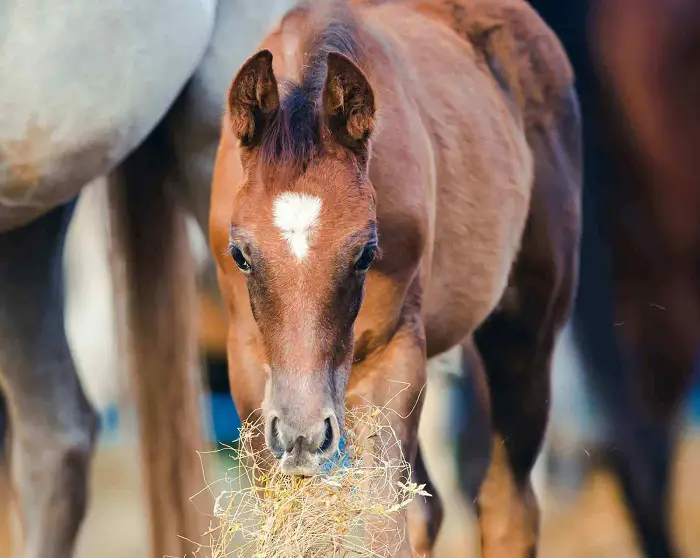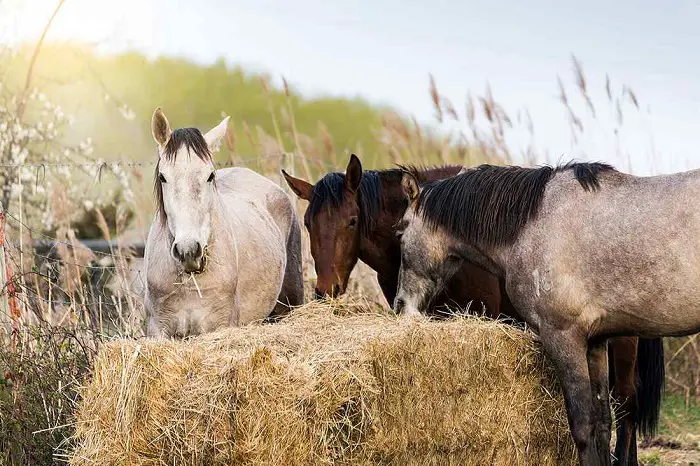Botulism in horses is a serious and potentially fatal condition caused by the toxin produced by the bacterium Clostridium botulinum. This bacterium is commonly found in soil and can produce a potent neurotoxin, botulinum toxin. Horses are particularly susceptible to botulism due to their grazing habits and the fact that they are hindgut fermenters.
Causes of Equine Botulism
Equine botulism is a severe but rare neurological disease that affects horses. It is caused by the toxin produced by the bacterium Clostridium botulinum. Here are the leading causes of equine botulism:
- Ingestion of Contaminated Feed: Horses can acquire botulism by consuming feed contaminated with the bacterium or its spores. This typically occurs when the feed is stored improperly, such as in damp or anaerobic conditions that allow the growth of Clostridium botulinum. Contaminated hay, silage, or grains can be sources of the bacteria.
- Spores in the Environment: Horses can come into contact with Clostridium botulinum spores in the environment. These spores can be found in soil, dust, or plant material. When horses graze or consume vegetation contaminated with spores, they can become infected.
- Improperly Preserved Forage: The growth of Clostridium botulinum is favored by anaerobic conditions. If forage, such as haylage or silage, is not adequately fermented and preserved, it can create an environment suitable for the bacteria to produce toxins. If horses consume contaminated forage, they can develop botulism.
- Wound Contamination: Equine botulism can sometimes occur when horses have wounds infected with Clostridium botulinum. The bacteria can enter the body through open wounds, particularly puncture wounds or those caused by surgeries. This form of botulism is known as wound botulism.
- Shaker Foal Syndrome: Shaker foal syndrome is a botulism affecting foals. It occurs when foals ingest the toxin produced by Clostridium botulinum, which can be present in the mare’s milk or contaminated bedding. This typically happens when the mare consumes the bacteria or its spores and passes them on to her foal.
Transmission of Botulism in Horses
Equine botulism is not a contagious disease that can be directly transmitted from one horse to another. Instead, it is caused by ingesting the toxin produced by the bacterium Clostridium botulinum or its spores.
Clinical signs of Equine Botulism
Equine botulism can present with various clinical signs, and the severity of symptoms can vary depending on the type and amount of toxin ingested. Here are some common clinical signs associated with equine botulism:
- Progressive Muscular Weakness: One of the hallmark signs of equine botulism is progressive muscle weakness. Horses may exhibit a wobbly or unsteady gait, weakness in the hind limbs, difficulty swallowing, and drooping of the lower lip. As the disease progresses, the weakness can affect the entire body, leading to difficulty standing and eventual paralysis.
- Difficulty Swallowing and Eating: Horses with botulism often have difficulty swallowing, which can lead to the accumulation of food or saliva in the mouth. They may drool or have excessive salivation. As a result, affected horses may lose their appetite, have trouble eating or drinking, and exhibit weight loss.
- Generalized Muscle Tremors: Some horses with botulism may display muscle tremors or twitches. These tremors are often more noticeable in the face and neck region and can be exacerbated by stress or physical exertion.
- Lethargy and Depression: Affected horses may appear lethargic, depressed, or unresponsive. They may have a reduced interest in their surroundings, exhibit a lower energy level, and be less reactive to stimuli.
- Respiratory Difficulties: In severe cases, equine botulism can affect the muscles responsible for breathing, leading to respiratory difficulties. Horses may exhibit labored breathing, flared nostrils, and an increased respiratory rate. In some cases, respiratory failure can occur, which can be life-threatening.
Diagnosis of Botulism in Horses
Diagnosing equine botulism involves a combination of clinical signs, history, and laboratory testing. It’s essential to involve a veterinarian for an accurate diagnosis. Here are the main diagnostic methods used for equine botulism:
- Clinical Examination: The veterinarian will thoroughly examine the horse, paying close attention to the presenting signs and symptoms. They will evaluate the horse’s gait, muscle strength, swallowing ability, and overall neurological function.
- History and Observation: The veterinarian will gather information about the horse’s recent feed and water sources, management practices, and any known exposure to potential sources of botulism. Observing the horse’s environment and discussing the timeline of symptom onset can provide valuable clues for diagnosis.
- Laboratory Testing: Laboratory testing is crucial to confirm a diagnosis of equine botulism. The most common test involves collecting samples, such as serum, feces, or feed, to detect the presence of the botulinum toxin or its antibodies. The samples are sent to a diagnostic laboratory for analysis.
- Electromyography (EMG): Electromyography is a diagnostic test that measures the electrical activity in muscles. It can help identify abnormalities in the muscles affected by botulism. EMG may be used in cases where the diagnosis is unclear or to provide additional evidence.
Differential Diagnosis of Equine Botulism
Equine botulism can present with clinical signs similar to other neurological conditions or toxicities. Therefore, it’s essential to consider a range of differential diagnoses when evaluating a horse with suspected botulism. Here are some potential differential diagnoses for equine botulism:
- Equine Protozoal Myeloencephalitis (EPM): EPM is a neurological disease caused by the protozoan parasites Sarcocystis neurona or Neospora hughesi. It can cause similar signs of muscle weakness, ataxia, and difficulty swallowing in horses. Laboratory tests such as cerebrospinal fluid analysis or serological tests can help differentiate EPM from botulism.
- Equine Herpesvirus (EHV): Certain strains of equine herpesvirus, particularly EHV-1, can lead to neurological symptoms in horses. EHV-1 myeloencephalopathy can cause ataxia, weakness, and incoordination. Laboratory tests, including PCR (polymerase chain reaction) or viral isolation, can help confirm the presence of EHV-1.
- Tetanus: Tetanus in horses, caused by the bacterium Clostridium tetani, can result in similar signs of muscle stiffness, spasms, and difficulty swallowing. However, tetanus is usually associated with wound contamination rather than ingestion. The presence of specific clinical signs, such as a rigid tail or “sawhorse” stance, can help differentiate tetanus from botulism.
- Other Toxicities: Various toxins can lead to neurological symptoms in horses. For example, ingesting certain plants, such as yellow star thistle or blister beetles, can cause muscle weakness and ataxia. Toxic substances, including lead or organophosphate pesticides, can produce similar neurological signs.
- Traumatic or Inflammatory Conditions: Spinal cord injuries, traumatic brain injuries, or inflammatory conditions like equine encephalitis can result in similar clinical signs. A thorough examination, including neurological evaluations and imaging techniques like radiography or ultrasound, can aid in distinguishing these conditions from botulism.
Treatment of Botulism in Horses
Treating equine botulism involves supportive care, administration of antitoxin, and addressing the underlying cause. Prompt veterinary intervention is crucial to maximize the chances of recovery. Here are some standard treatment measures for equine botulism:
- Administration of Antitoxin: Equine botulism antitoxin is a specific product that can neutralize the botulinum toxin in the horse’s body. It is typically given intravenously or intramuscularly. The antitoxin helps prevent further binding of the toxin to nerve receptors and can help reduce the severity and progression of clinical signs.
- Supportive Care: Supportive care is essential for managing affected horses. This includes providing a quiet and comfortable environment to minimize stress, as stress can exacerbate clinical signs. Horses with difficulty swallowing may require soft or slurry-type feeds, and in severe cases, temporary tube feeding or intravenous fluids may be necessary to maintain hydration and nutrition.
- Symptomatic Treatment: Specific symptoms associated with equine botulism may require additional treatment. For example, respiratory support, such as oxygen therapy or assisted ventilation, may be needed if respiratory function is compromised. Appropriate wound care and antibiotics may be necessary if a wound infection occurs.
- Addressing the Underlying Cause: The underlying cause of botulism should be addressed to prevent further exposure and infection. This may involve improving feed storage practices, ensuring a clean and safe water supply, or addressing wounds or contaminated environments.
- Rehabilitation and Monitoring: Once the acute phase of botulism is managed, horses may require a period of rehabilitation and monitoring. This can include physical therapy, assistance with standing and walking, and gradual reintroduction of standard feed and water. Regular veterinary check-ups are essential to monitor progress and detect any complications.
Prevention of Equine Botulism
Preventing equine botulism is critical to avoiding the disease in horses. Here are some essential prevention measures:
- Proper Feed Storage: Clostridium botulinum thrives in anaerobic conditions, so storing feed properly is essential. Ensure that hay, grains, and other feedstuffs are stored in a dry, well-ventilated area. Avoid storing feed in damp or moldy conditions, as these can create an environment suitable for bacterial growth.
- Good Forage Management: Pay attention to the quality of forage. Harvest and store hay properly, ensuring it is free from mold or spoilage. If using silage or haylage, follow proper fermentation and storage techniques to minimize the risk of bacterial growth.
- Hygienic Feeding Practices: Practice good hygiene when handling feed and water. Wash hands thoroughly before and after handling feed, and use clean utensils and containers. Avoid cross-contamination by not mixing old and new feed batches.
- Water Source Management: Provide clean and fresh water to horses. Regularly clean and maintain water troughs, ensuring they are free from debris and contamination. Avoid stagnant water sources, as they can be breeding grounds for bacteria.
- Vaccination: Vaccination can be an effective preventive measure for botulism. A botulism toxoid vaccine can help stimulate the horse’s immune system to produce antibodies against the botulinum toxin. Consult with a veterinarian to determine if vaccination is recommended for your horse based on the risk factors in your region.
- Avoid Grazing in Specific Areas: Be cautious when allowing horses to graze where decaying plant material or carcasses are present, as they can be potential sources of Clostridium botulinum. Ensure pastures are kept clean and free from debris that may harbor the bacteria.
- Prompt Wound Care: Proper wound care is vital to prevent wound botulism. Clean and treat wounds promptly to minimize the risk of infection by Clostridium botulinum or other bacteria.
- Awareness and Education: Stay informed about equine botulism and its prevention. Educate barn staff, owners, and caretakers about the disease, its signs, and preventive measures to reduce the risk of exposure.
Concluding Words on Botulism in Horses
Equine botulism is a severe condition that can have debilitating effects on horses. Understanding its causes, clinical signs, diagnosis, treatment, and prevention is essential for horse owners and caretakers. Botulism is primarily caused by ingesting the botulinum toxin or its spores from contaminated feed, forage, or water sources. It can also occur through wound contamination or in foals through ingesting the toxin in the mare’s milk.
The clinical signs of equine botulism include progressive muscle weakness, difficulty swallowing, muscle tremors, lethargy, and respiratory difficulties in severe cases. Prompt veterinary intervention is crucial for diagnosis and treatment. Laboratory testing, such as detecting the botulinum toxin or its antibodies, is typically performed to confirm the diagnosis. Supportive care, administration of antitoxin, and addressing the underlying cause are essential components of treatment.
Prevention plays a vital role in mitigating the risk of equine botulism. Proper feed storage, good forage management, hygienic feeding practices, and water source management are essential preventive measures. Vaccination and avoiding grazing in certain areas can also help reduce the risk. Prompt wound care and maintaining a clean environment are additional preventive strategies.
You must seek veterinary assistance immediately if you suspect equine botulism in your horse. Consult a veterinarian for specific guidance and recommendations tailored to your horse’s needs and circumstances.
By being vigilant, implementing preventive measures, and working closely with your veterinarian, you can help protect your horses from equine botulism and promote their health and well-being.



